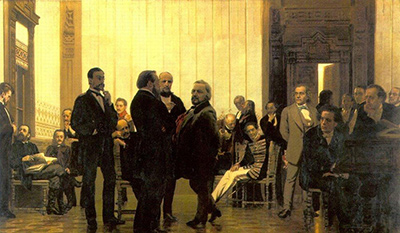This magnificent painting featuring twenty-two Slavic composers was completed in 1872 by Ilya Repin as a commission for a Moscow Industrialist and entrepreneur named Alexander Porokhovshchikov.
Porokhovshchikov had initially sought the services of another painter for this piece, Konstantin Makovsky, but his fee was too high so he engaged Repin who agreed to a much lower sum instead. The commission was for a painting which featured the great composers from Russia, Poland and the Czech Republic, both alive and deceased. It was destined to be hung in the Slavic Bazaar which was a hotel, restaurant and concert hall on 17 Nikolskaya Street, Moscow. Alphonse Mucha later produced the Slav Epic series. The impressive painting features great composers gathered together in an imaginary meeting. The grand room is bathed in a wonderful light and filled with talented composers who could never have been in the same room together.
The two composers at the piano are the brothers Anton and Nikolay Rubinstein. Younger brother Nikolay reportedly drew up a list of characters for the painting, some alive and some of the late, great composers from the past. Czech composer, Smetana sits on the left hand side of the painting looking through a musical score with conductor and composer, Napravnik. Rimsky-Korsakov, wearing spectacles, appears pensive and is stroking his distinctive beard. The three central figures are Odoevsky, Balakirev and Glinka, who was considered to be the father of "Russian music". In the upper right of the painting are a group of Polish composers, Oginski, Chopin (holding a score) and Moniuszko.
The seated figure in the distinctive uniform is Count Alexei Lvov, who is credited with composing the first National anthem of Russia. He was also a violinist, conductor and a composer. Other composers featured include, Bortniansky, Serov, Laskovsky and Dargomyzhsky. It is almost as interesting to note who is not featured in the painting, namely Tchaikovsky, Mussorgsky and Borodin. Sources indicate that Nikolay Rubinstein felt that these composers were too young and not yet deserving of a place in the painting. This was despite Tchaikovsky being a good friend of his and a peer. Yet young Rimsky-Korsakov does feature in the painting. Repin did eventually paint the Russian composer Mussorgsky in his 1881 portrait painting titled "Modest Mussorgsky".
When the Slavic Composers painting was first displayed at the hotel, it received mixed reactions. Some felt it was a wonderful and significant piece of Russian art whilst some disliked the "motley" mix of dead and living composers grouped together. In 1941, during the Second World War, a German bomb damaged the stained glass window of the Grand Hall of the Moscow Conservatory. The window was quickly patched, but after the war, the painting of the Slavic composers was moved to this position and remained there until 2011 when the beautiful window featuring Saint Cecilia was restored.
To complete so many portraits of such significant people in one single painting must have been an enormous challenge. It is a remarkable painting, rich in detail, encouraging the viewer to study the different groupings and imagine the lively conversation and interaction. Interestingly the door to the room is painted ajar, perhaps waiting for the next generation to come through.




